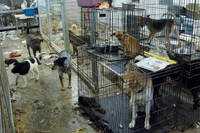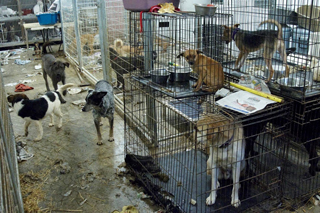
St. Francois Society 320

Photo courtesy of the Humane Society of Missouri
A no-kill rescue group in rural Missouri, the St. Francois Society, lost its state license in 2011 for multiple animal health and welfare violations. Nearly 200 cats and dogs were confiscated. The shelter had been so crowded that some animals roamed loose in the unkempt facility.
The no-kill movement for cats and dogs, begun in the late 1980s and early 1990s, was based on a radical and noble idea: No healthy cat or dog in the United States should be euthanized simply due to lack of shelter space or homelessness. Thus began a massive effort to have more cats and dogs adopted from shelters rather than bought from breeders or pet stores, and to have the animals desexed prior to adoption.
The effort has worked wonders. The euthanasia rate has plummeted. While exact numbers are hard to discern for a myriad of reasons, the number of stray pets euthanized, estimated at 13.5 million in the 1970s, as reported recently in the New York Times, decreased to 2.6 million in 2011, and is down to 1.5 million now, according to the American Society for the Prevention of Cruelty to Animals. This is tremendous progress and should be celebrated. However, the no-kill movement has a dark side of unintended consequences.
Between the two of us, we have been veterinarians for over 40 years. Our careers have encompassed private practices and shelter organizations, both municipal and non-governmental. While we applaud the efforts to decrease the number of animals euthanized, we are concerned that some of those efforts have led to substantially decreased animal welfare. We have seen the ramifications firsthand.
Goodhart's law states that "when a measure becomes a target, it ceases to be a good measure." In the no-kill movement, the goal often is to do anything but euthanize an animal.
Dr. Jennifer Woolf 250

Photo courtesy of Dr. Jennifer Woolf
Dr. Jennifer Woolf
Understanding that there will always be some animals that require humane euthanasia, the benchmark of a no-kill facility is to have 90% of its animals leave the facility alive. The live-release rate is calculated by taking the total number of animals leaving a facility alive and dividing it by the total number of animals leaving, whether alive or deceased, not including those presented for euthanasia by their owners. The number of animals that are taken in or held by the organization have no part in the calculation.
Because a shelter's reputation with the public and its ability to obtain funding often depends on this target measurement, a shelter's goal may become to keep an animal alive, regardless of its welfare or its risk to society. The main way to accomplish this goal is to adjust the numbers used in calculating the statistics. This can be done by decreasing intake of animals, releasing more animals, or holding animals that otherwise would be euthanized.
For example, Fox 2 in St. Louis reported in July that an audit uncovered a higher-than-reported euthanasia rate at St. Louis County Animal Care & Control. Shelter personnel had all owners who surrendered their pet for rehoming check a box marked "ORE," without explaining that it was an acronym for "Owner Requests Euthanasia," and that by checking the box, they were requesting euthanasia for their pet. Because animals surrendered for euthanasia are not counted in the statistics, this tactic artificially reduced the shelter's euthanasia numbers to stray or otherwise unowned animals.
Limited-admission organizations can artificially adjust their live-release rates by limiting the number of and kinds of animals they admit. Such organizations are often nonprofit shelters and rescues. Because they are not bound by public laws requiring intake of unwanted or unowned animals, they may refuse to take animals that are considered less adoptable, such as chronically ill, injured or aged animals or less desirable breeds or types. They can also refuse admission to animals in order to reduce or stabilize their numbers. In this manner, they avoid overcrowding while maintaining a high live-release rate.
Dr. Julie Brinker 250

Photo by Coreena Watson
Dr. Julie Brinker
Another technique is to deliberately choose specific types of animals for the shelter. If a shelter obtains animals from a facility with a higher euthanasia rate, as is common, they may drive past local shelters and through multiple counties or states in a search for desirable animals like small, fluffy dogs.
Open-admission organizations take in all animals, in keeping with their mission or requirements in government contracts. Since they cannot control their intake numbers as easily, these facilities must develop other methods to achieve a 90% live-release rate. They do this typically by some combination of holding animals longer (which does not count in the live-release rate) or by transferring animals to other organizations. Another method, utilized less often, is to decrease intake by reducing the effort to round up strays, or refusing animals outside their contracted geographic region, even if those areas have no safe place for unwanted animals to go.
Once a facility has an animal, there are four pathways for that animal:
- Adopt it to a person.
- Send it to a different shelter or rescue group.
- Keep the animal for the rest of its natural life.
- Euthanize it.
Adoption to a new home is the primary goal of most organizations and is obviously the best for everyone, including the animal. In one heartwarming story, Fox News reported in September about a dog in Kansas that found an adoptive home after spending more than 400 days in a shelter.
When good intentions go bad
When an animal is passed up by adopters for whatever reasons, it may be transferred to another shelter. While working to improve their live-release rate, some facilities may feel pressured to get animals out any way they can, especially if they cannot control how fast they are coming in. Therefore, they may be lax about first ensuring any secondary shelter or rescue group is caring for their current animals appropriately, much less has the capacity to care for more. As such, when the first shelter transfers an animal to a different shelter or rescue, it may be unintentionally enabling an animal hoarder.
Some animals must be shipped over state lines and across the country in order to reach a place willing to accept them. While this may have the benefit of moving animals that are not adoptable in one area of the country to somewhere that they may be desired, this approach has drawbacks.
One, it increases the risk of disease movement. Two, the medical and behavioral records for the animals may be incomplete, inaccurate or absent, a risk that rises with the number and frequency of transports. Finally, frequent transport can make it harder for source shelters to screen destination organizations, confirming that they properly care for their charges.
In the extreme, some organizations may send an animal that should be euthanized to a facility that does not claim a "no kill" philosophy, knowing it will be euthanized there. In this way, the first organization can massage its books to still claim the transferred animal as a live-release in their statistics. The second organization, however, ends up with a higher euthanasia rate, as a result.
In addition, open-admission organizations located near limited-admission facilities often experience a higher intake rate that is skewed to the less-desirable animals, as their neighbors have sifted out the best animals to rehome. This compounds the problem by creating an almost second-class facility to which fewer people will donate because its euthanasia rate has risen.
The third pathway for an animal is to live at the shelter, because the live-release rate does not count the animals that stay in a facility. As a result, some shelters and rescues become hoarders, believing that any existence is better than euthanasia. Oftentimes, this happens because those in charge of such secondary, limited-admission shelters and rescues find it difficult to say "no" to requests to take less-adoptable animals. For instance, they may feel pressure from constant requests from overcrowded shelters, social media and donors to take "just one more." If it goes too far, they ultimately agree to possess more animals than they can care for, and they become overcrowded themselves.
As an example, the St. Francois Society shelter in Missouri was closed in 2011 and its animal inhabitants removed after the overcrowded shelter was found by state regulators to have numerous violations that jeopardized the health and welfare of the animals.
Overcrowding and long-term kenneling at any shelter results in increasing stress among the inhabitants. The stress can manifest as severe behavioral problems such as aggression, food- and resource-guarding, separation anxiety and stereotypies, which are repetitive movements or utterances. In addition to causing behavioral problems, overcrowding can result in a failure by personnel to provide for even the basic needs of the animals in their care. This can, and has, resulted in serious neglectful and abusive situations; at the extreme, it can result in large-scale death of animals. For instance, in late September, a couple who operated an animal rescue was charged with multiple offenses after authorities found 150 dead dogs on properties in Missouri and Texas associated with their operation, according to a report by USA Today.
The fourth option, euthanasia, is one that shelters — whether limited-admission or open-admission — want to avoid. If no animal ever needed euthanasia, the organizations would be happy.
Solutions to the unintended consequences of the no-kill movement include:
- Dropping the term "no-kill," since it is inflammatory, inaccurate and causes division between groups that share a goal of helping animals.
- Requiring licensing, regulatory inspection and enforcement of welfare rules at animal shelters and rescues in all states. This would provide a baseline for a facility to be considered an acceptable place to send animals for sheltering. Until such legislation can be passed, shelters should require a minimum level of care that can be ascertained or audited amongst themselves.
- Encouraging grant money and other funding to be provided for improvement of animal welfare only, allowing for broader acceptable ranges of live-release rates and euthanasia rather than a specific number.
- Educating the public in the different services and missions of varying types of shelters and rescues, so that they might recognize that comparing open-admission and limited-admission shelters is like comparing cats and dogs.
- Increasing efforts to educate shelters, rescue groups and the public in proper physical and mental care of animals. Serious behavioral problems constitute welfare deficiencies just as much as medical problems do. Education will help all animals to receive better care, and the public will be doing its part to decrease the need for animal shelters in the first place.
Just as different types of tools serve different purposes, we need to recognize that different types of shelters serve different purposes, as well. And in the same way that a box with nothing but hammers is not as useful as a collection of multiple tools, a community is better served by acknowledging the benefits of multiple types of animal shelters and supporting all of them. This cannot be accomplished by setting an arbitrary number as a goal for all.
About the authors:
Dr. Jennifer Woolf received her DVM and MS (with a concentration in veterinary forensic sciences) from the University of Florida. She has worked in private practice and in animal welfare organizations, including doing relief work at almost 50 locations in the San Francisco Bay Area. In 2014, she founded Woolf Veterinary Forensics Consulting. She lectures internationally on animal abuse, the link between animal abuse and violence to people, and veterinary forensics, as well as consults on individual cases. Woolf also teaches in the UF Veterinary Forensic Sciences program, has published numerous articles and a book chapter on animal cruelty, and was a 2018-19 Don Low-CVMA Practitioner Fellow at the University of California, Davis, in the Anatomic Pathology Department. She is a member of the Veterinary Information Network indexing team and educates on animal abuse topics for VIN.
Dr. Julie Brinker received her DVM from the University of Missouri and her MS (with a concentration in veterinary forensic sciences) and graduate certificate in shelter medicine from the University of Florida. She has been employed for more than 18 years by the Humane Society of Missouri, where she handles animal-cruelty and -neglect cases from across the state, and provides medical care to animals at the organization's two small animal shelters. Brinker also teaches in the University of Missouri shelter medicine elective clinical rotation and the UF Veterinary Forensic Sciences program, has published a chapter in a recent veterinary forensics textbook, and lectures internationally on veterinary forensics and on behavioral and medical care of shelter animals.